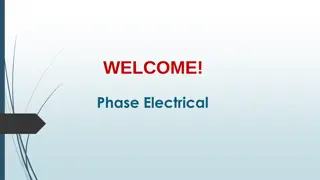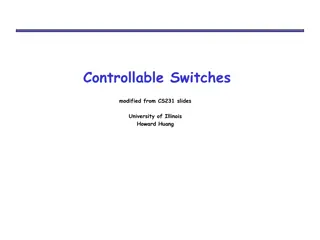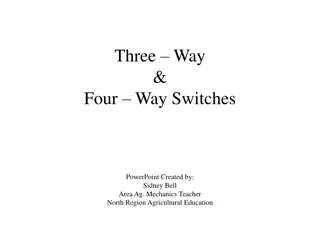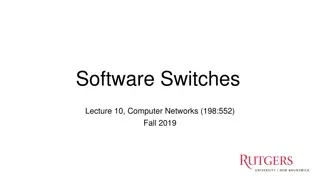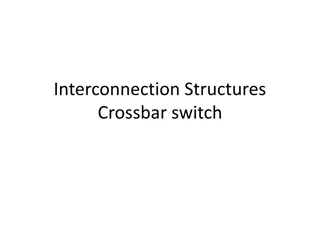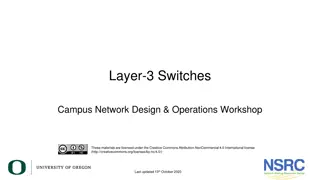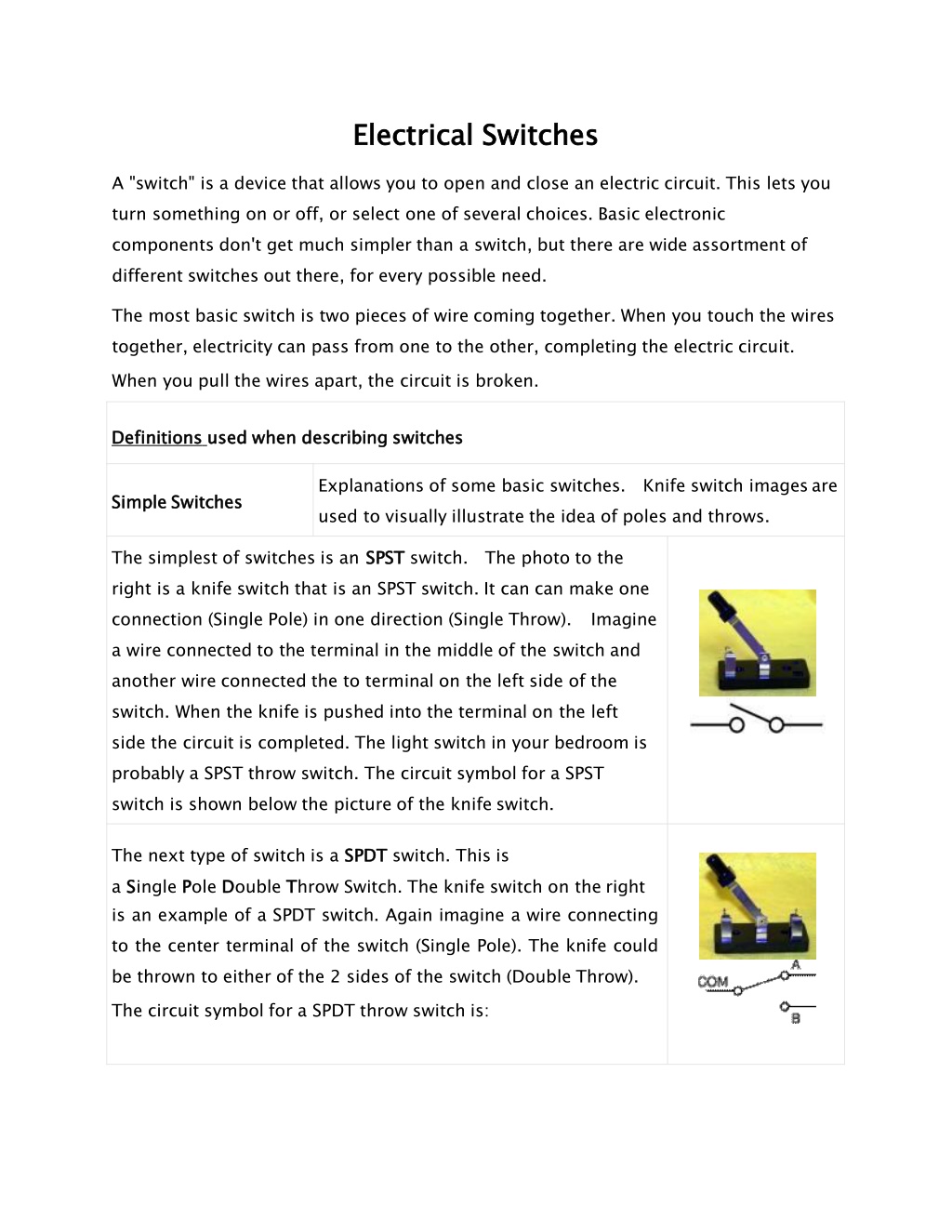
Understanding Different Types of Electrical Switches
Learn about the basic concepts of electrical switches, including SPST, SPDT, DPST, DPDT switches, and momentary switches. Discover how these switches function and their applications in electric circuits.
Download Presentation

Please find below an Image/Link to download the presentation.
The content on the website is provided AS IS for your information and personal use only. It may not be sold, licensed, or shared on other websites without obtaining consent from the author. If you encounter any issues during the download, it is possible that the publisher has removed the file from their server.
You are allowed to download the files provided on this website for personal or commercial use, subject to the condition that they are used lawfully. All files are the property of their respective owners.
The content on the website is provided AS IS for your information and personal use only. It may not be sold, licensed, or shared on other websites without obtaining consent from the author.
E N D
Presentation Transcript
Electrical Electrical Switches Switches A "switch" is a device that allows you to open and close an electric circuit. This lets you turn something on or off, or select one of several choices. Basic electronic components don't get much simpler than a switch, but there are wide assortment of different switches out there, for every possible need. The most basic switch is two pieces of wire coming together. When you touch the wires together, electricity can pass from one to the other, completing the electric circuit. When you pull the wires apart, the circuit is broken. Definitions Definitions used used when when describing describing switches switches Explanations of some basic switches. used to visually illustrate the idea of poles and throws. Knife switch imagesare Simple Simple Switches Switches The simplest of switches is an SPST right is a knife switch that is an SPST switch. It can can make one connection (Single Pole) in one direction (Single Throw). a wire connected to the terminal in the middle of the switch and another wire connected the to terminal on the left side of the switch. When the knife is pushed into the terminal on the left side the circuit is completed. The light switch in your bedroom is probably a SPST throw switch. The circuit symbol for a SPST switch is shown below the picture of the knife switch. SPST switch. The photo to the Imagine The next type of switch is a SPDT a S Single P Pole D Double T Throw Switch. The knife switch on the right is an example of a SPDT switch. Again imagine a wire connecting to the center terminal of the switch (Single Pole). The knife could be thrown to either of the 2 sides of the switch (Double Throw). The circuit symbol for a SPDT throw switch is: SPDT switch. This is
The photos on the right are photos of a DPST (Double Pole Single Throw) Switch and a DPST (Double Pole Double Throw) Switch. It is important for a team to understand the DPDT switch because a DPDT switch can be wired so that it can reverse the direction a DC motor is turning. The image at the right shows how to wire a DPDT switch as a reversing switch. The power feeds (red line + and black line -) are cross wired to the two "throws" of the switch. the motor leads (blue wires) are connected to the common terminals in the center of the switch. This allows the switch to reverse the polarity of the power going to the motor. There is a solid state device that works similar to a DPDT switch wired as a revesing switch. It is called an "H-Bridge" . It is often used in electronic motor control circuitry. Teams can find tutorials on the H Bridge by doing a google search. photo of dpdt knife switch wired as a reversing switch
Momentary Momentary. A momentary switch is switch that is only "working" when the user is activating it - usually by pressing on a button. Momentary switches can be either "normally closed" or "normally open" switches. With a normally open switch the circuit is open until the user pushes the button. An example of a normally open switch would be your front door bell button. With a "normally closed" switch the circuit is complete ( or closed) until the user pushes the button. An example of a normally closed switch would be the switch that controls the light in you refrigerator when you open the door. When the door is closed the button is pushed and the circuit opens thus turning off the light (at least I think it goes out). When the refrigerator door is opened the button is no longer being pushed so the light turns on. Momentary Switches: Switches: Some switches are classified as Click for Click for a a chart showing additional chart showing additional type types of of switches switches Switch actuator type Switch actuator refers to the type of mechanical action required to to activate a switch. Actuator types can include toggle, pushbutton, slide and magnetic. List common List of most of most common switch actuator switch actuator types. types. Switch Contact Ratings One of the things you must consider when purchasing a switch is the amount of voltage and current (amps) that you will be controlling with the switch. Most of the time the packaging for the switch will include information on the maximum voltage and amperage that the switch is rated for. If you are working with smaller DC hobby type motors and light then most switches that you can purchase at your local electronics store are more than adequate although there are some smaller reed (magnetic) switches that may not be rated for even the small loads of the hobby motors and lights. The important thing is to read the labels and use switches that are rated at or above the voltage and amperage loads of your circuit. As you start using more powerful motors and other devices that use 6 Volts or more of electricity you will have to look more carefully for switches that meet your requirements.
Source: Source: Electrical Switches A "switch" is a device that allows you to open and close an electric circuit. This lets you turn something on or off, or select one of several choices. Basic electronic components don't get much simpler than a switch, but there are wide assortment of different switches out there, for every possible need. The most basic switch is two pieces of wire coming together. When you touch the wires together, electricity can pass from one to the other, completing the electric circuit. When you pull the wires apart, the circuit is broken. Definitions Definitions used used when when describing describing switches switches Explanations of some basic switches. are used to visually illustrate the idea of poles and throws. Knife switch images Simple Simple Switches Switches The simplest of switches is an SPST right is a knife switch that is an SPST switch. It can can make one connection (Single Pole) in one direction (Single Throw). a wire connected to the terminal in the middle of the switch and another wire connected the to terminal on the left side of the switch. When the knife is pushed into the terminal on the left side the circuit is completed. The light switch in your bedroom is probably a SPST throw switch. The circuit symbol for a SPST switch is shown below the picture of the knife switch. SPST switch. The photo to the Imagine
The next type of switch is a SPDT a S Single P Pole D Double T Throw Switch. The knife switch on the right is an example of a SPDT switch. Again imagine a wire connecting to the center terminal of the switch (Single Pole). The knife could be thrown to either of the 2 sides of the switch (Double Throw). The circuit symbol for a SPDT throw switch is: SPDT switch. This is The photos on the right are photos of a DPST (Double Pole Single Throw) Switch and a DPST (Double Pole Double Throw) Switch. It is important for a team to understand the DPDT switch because a DPDT switch can be wired so that it can reverse the direction a DC motor is turning. The image at the right shows how to wire a DPDT switch as a reversing switch. The power feeds (red line + and black line -) are cross wired to the two "throws" of the switch. the motor leads (blue wires) are connected to the common terminals in the center of the switch. This allows the switch to reverse the polarity of the power going to the motor. There is a solid state device that works similar to a DPDT switch wired as a revesing switch. It is called an "H-Bridge" . It is often used in electronic motor control circuitry. Teams can find tutorials on the H Bridge by doing a google search. photo of dpdt knife switch wired as a reversing switch
Momentary Momentary. A momentary switch is switch that is only "working" when the user is activating it - usually by pressing on a button. Momentary switches can be either "normally closed" or "normally open" switches. With a normally open switch the circuit is open until the user pushes the button. An example of a normally open switch would be your front door bell button. With a "normally closed" switch the circuit is complete ( or closed) until the user pushes the button. An example of a normally closed switch would be the switch that controls the light in you refrigerator when you open the door. When the door is closed the button is pushed and the circuit opens thus turning off the light (at least I think it goes out). When the refrigerator door is opened the button is no longer being pushed so the light turns on. Momentary Switches: Switches: Some switches are classified as Switch actuator type Switch actuator refers to the type of mechanical action required to to activate a switch. Actuator types can include toggle, pushbutton, slide and magnetic. List common List of most of most common switch actuator switch actuator types. types. Switch Contact Ratings One of the things you must consider when purchasing a switch is the amount of voltage and current (amps) that you will be controlling with the switch. Most of the time the packaging for the switch will include information on the maximum voltage and amperage that the switch is rated for. If you are working with smaller DC hobby type motors and light then most switches that you can purchase at your local electronics store are more than adequate although there are some smaller reed (magnetic) switches that may not be rated for even the small loads of the hobby motors and lights. The important thing is to read the labels and use switches that are rated at or above the voltage and amperage loads of your circuit. As you start using more powerful motors and other devices that use 6 Volts or more of electricity you will have to look more carefully for switches that meet your requirements.
Used for testing voltage on electrical outlets, fuse clips, and circuit breakers will test voltage from 120 to 600 volts.
Multi-Tester or Volt-Ohm Meter An analog or digital meter that commonly will measure AC volts, DC volts, Ohms, and milli-amps.
WireStripper Used to strip plastic coating from solid electrical wires without damaging the wire .Can be adjusted to be used on various wire sizes.
Lineman's Pliers They are used on both bare and insulated wire. Note: These tools are also used for fence work and tying concrete rebar.
NM CableCutter A cutter for cutting Type NM cable.
ConduitBender This enables an electrician to make accurate 45 and 90 degree bends. Bender may be designated for EMT or rigid conduit.
Long Nose Pliers Also used for stripping wire, making eyes in wire and holding wire in place while inserting screws.
Wire Stripper And Crimping Tool Used for stripping wire, cutting wire and crimping wire terminals on stripped wire ends.
FusePuller Made of plastic to prevent electrician from being shocked while installing or removing fuses.
Electric Soldering Iron It has a replaceable copper tip. Soldering irons are sized from very light duty for soldering fine wires to heavy duty for soldering sheet metal.
Soldering Gun It is fitted with a replaceable tip and operates on 115-volt AC. Used primarily for soldering wires.
Armored Cable This cable must run from box to box without splices.
CircuitBreaker Used to protect the wire in a circuit. Rated in amps.
Single Conductor A single conductor with thermal plastic insulation. Wire may be solid or stranded. Typical types are TW and THHN. Common sizes 14-0
Lampholder A plastic or porcelain device that holds a lamp.







